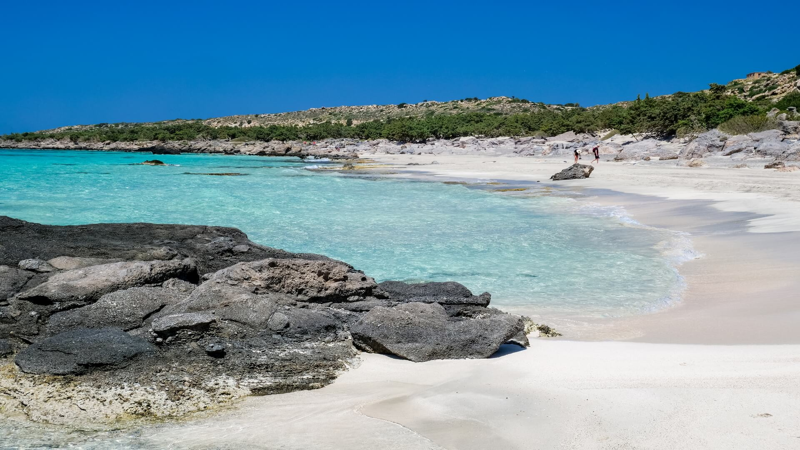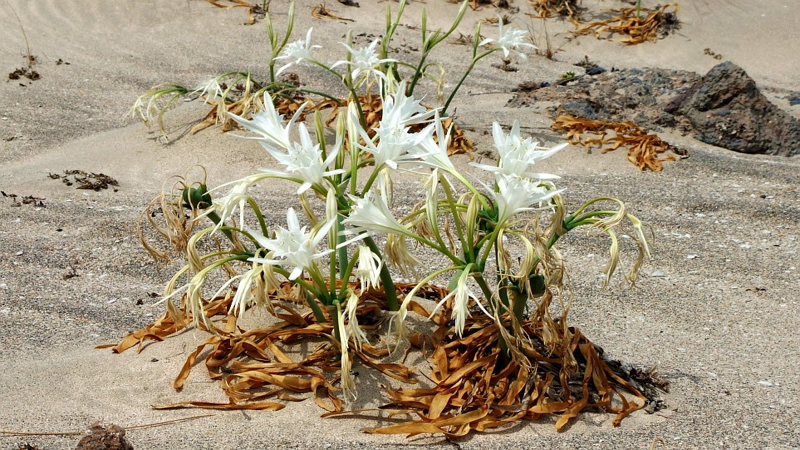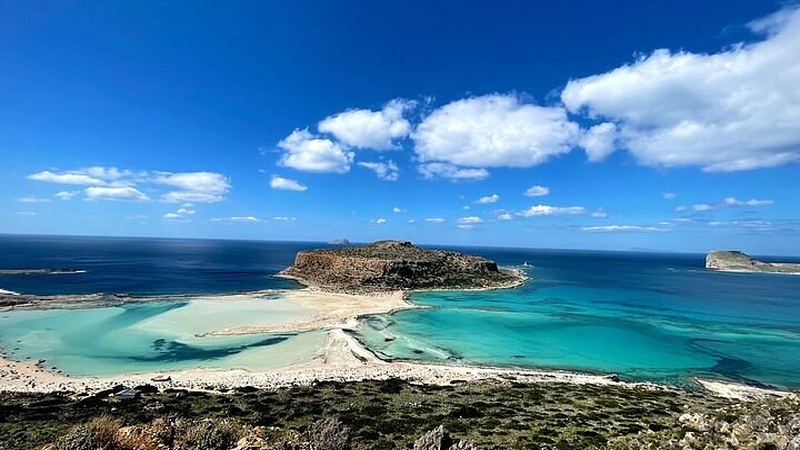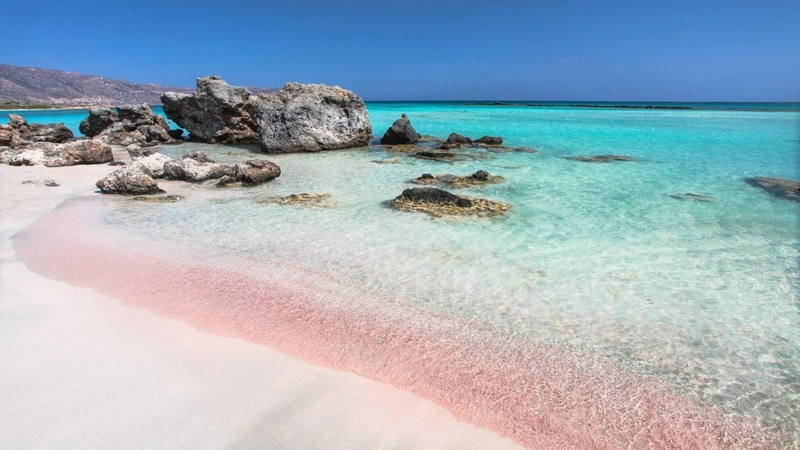Kedrodasos Beach Crete: Hidden Cedar Forest Paradise
Discover the untouched beauty of ancient cedar trees growing from pristine white sand - Crete's best-kept secret beach
Kedrodasos Beach: Crete's Pristine Cedar Forest Paradise
Just 7km from the famous Elafonisi lies Kedrodasos Beach (meaning "Cedar Forest" in Greek), one of Crete's most pristine and unspoiled natural treasures. This hidden paradise features ancient juniper trees growing directly from white sand dunes, crystal-clear turquoise waters, and a sense of wild tranquility that's increasingly rare in the Mediterranean. Unlike its popular neighbor, Kedrodasos remains blissfully undeveloped with no facilities whatsoever, offering visitors a genuine escape into nature. This guide provides everything you need to know about visiting this extraordinary beach—from detailed directions and preparation tips to the best swimming spots and photographic opportunities.
Contents
About Kedrodasos Beach
Kedrodasos Beach is one of Crete's most extraordinary natural treasures—a true paradise that combines pristine white sand, crystal-clear azure waters, and an ancient forest of juniper trees (often called cedars locally, hence the name). Unlike many of Crete's famous beaches, Kedrodasos remains largely untouched by tourism development, offering a rare glimpse of the Mediterranean coastline in its natural state.
The beach stretches for approximately 1 kilometer along Crete's southwestern coast, featuring multiple small coves and inlets surrounded by sand dunes where the juniper trees have taken root. These gnarled, ancient trees create a unique landscape unlike anywhere else on the island—their twisted trunks and umbrella-like canopies provide natural shade and an almost mystical atmosphere.
While the beach has gained some popularity in recent years, particularly among those seeking alternatives to the often-crowded Elafonisi, Kedrodasos remains relatively uncrowded even during peak season. The complete absence of facilities ensures that only more adventurous travelers make the effort to visit, helping preserve its natural beauty.


Kedrodasos is part of the European Natura 2000 network of protected areas due to its ecological significance. The beach and surrounding dune system host several rare plant species adapted to this harsh environment, and the entire area is considered a fragile ecosystem that requires conservation efforts.
The waters at Kedrodasos are exceptionally clear and typically calmer than at Elafonisi, making them perfect for swimming and snorkeling. The seabed slopes more gradually than at many Cretan beaches, allowing for comfortable swimming for all experience levels. On days with perfect clarity, visibility can extend to 20+ meters, revealing colorful fish and underwater rock formations.
How to Get to Kedrodasos Beach
Distance from Elafonisi Beach: 7 km (15 minutes by car + 15-20 minute walk)
GPS Coordinates: 35.2712423891518, 23.55979233628047 (Parking)
Walking Required: Yes, 15-20 minute hike from parking area
By Car (Recommended)
The only practical way to reach Kedrodasos is by car, followed by a short hike. There is no public transportation that will take you directly to this secluded beach.
From Chania to Kedrodasos:
- Follow the same route as you would to Elafonisi Beach (via Topolia Gorge)
- After passing through Elafonisi village, continue on the main road for approximately 500 meters
- Look for a dirt road on your right (there may be a small sign for "Kedrodasos" but often it's unmarked)
- Follow this dirt road for about 2km until you reach a small parking area near a radio antenna station
The Walking Trail from Parking to Beach
From the parking area, you'll need to continue on foot:
- Follow the path that leads southwest from the parking area
- The trail is marked occasionally with small stone cairns (stacked stones)
- The hike takes approximately 15-20 minutes at a moderate pace
- The path is mostly flat but crosses sandy and rocky terrain
- Proper footwear is recommended (not flip-flops)
As you near the beach, the path will lead you through the first cedar trees and over small sand dunes before opening up to reveal the stunning coastline.
Alternative Route: Walking from Elafonisi
It's also possible to reach Kedrodasos by walking from Elafonisi Beach:
- From the eastern end of Elafonisi, follow the coastline heading east
- This coastal path is approximately 3km long and takes about 45-60 minutes
- The route offers beautiful views but involves walking on uneven terrain
- Bring plenty of water as there's no shade for most of this walk
While this coastal walk is scenic, we recommend the car route for most visitors, especially in hot summer months or if carrying beach supplies.
Best Time to Visit Kedrodasos Beach
Best Time of Day: Early morning (before 11:00 AM) or late afternoon (after 4:00 PM)
Peak Season: July and August (but still much less crowded than Elafonisi)
Weather: Summer temperatures average 28-32°C (82-90°F)
Seasonal Considerations
Kedrodasos is most enjoyable during the shoulder seasons of late spring (May-June) and early autumn (September-October). During these periods, you'll benefit from:
- Comfortable temperatures (warm enough for swimming but not scorching hot)
- Very few visitors, sometimes having entire sections of beach to yourself
- Better visibility for underwater activities like snorkeling
- More pleasant hiking conditions for the walk to the beach
Even during peak summer months (July and August), Kedrodasos remains significantly less crowded than neighboring Elafonisi due to its lack of facilities and the effort required to reach it. However, these months bring intense heat that can make the exposed hike to the beach challenging.
Weather and Wind Considerations
The southwestern coast of Crete can experience strong winds, particularly in the afternoon. Kedrodasos is slightly more sheltered than Elafonisi thanks to its small coves and the protection offered by the cedar trees, but it's still affected by strong winds when they occur.
Check the wind forecast before planning your visit. On particularly windy days (common in July and August), the blowing sand can make the beach experience less pleasant. Conversely, on calm days, the water clarity at Kedrodasos is absolutely stunning, with visibility extending 20+ meters in some areas.
Naturist Considerations
Kedrodasos has traditionally been popular with naturists, particularly in its more secluded coves. If this aspect concerns you (especially when visiting with children), mornings tend to have fewer naturists present compared to afternoons and evenings. Naturism is most common in the eastern sections of the beach, while the western areas closer to Elafonisi typically see more conventional beachwear.
Essential Preparation for Kedrodasos
Unlike developed beaches, Kedrodasos has absolutely no facilities—no water, no food, no restrooms, no shade structures. Proper preparation is essential for an enjoyable visit:
Kedrodasos Beach Packing Essentials
- Minimum 2 liters of water per person
- Food and snacks for your entire stay
- Sun protection (hat, sunscreen, sunglasses)
- Proper footwear for the hike
- Beach umbrella (limited natural shade)
- Small first-aid kit
- Trash bags (carry all waste out with you)
- Toilet paper and small shovel
- Beach towel or mat
- Snorkeling equipment
- Power bank for mobile devices
- Small backpack for the hike
* Items marked with asterisk are absolutely essential
Water Requirements
The most critical consideration for Kedrodasos is bringing sufficient water. Dehydration is a real risk, especially in summer months when temperatures regularly exceed 30°C (86°F). We recommend:
- Minimum 2 liters per person for a half-day visit
- 3-4 liters per person for a full-day visit
- Additional water in your car for your return
Freezing water bottles the night before your visit helps keep them cold throughout the day and provides refreshing cold water even hours later.
Sun Protection
The sun in Crete is intense, particularly in summer. While the cedar trees provide some shade, it's limited and moves throughout the day.
- Bring a beach umbrella or sun shelter
- Apply waterproof sunscreen (SPF 30+) before arriving and reapply regularly
- Wear a wide-brimmed hat and UV-protective sunglasses
- Consider a UV-protective shirt for extended swimming sessions
Toilet Considerations
With no facilities whatsoever, toilet arrangements require planning:
- Use restroom facilities at Elafonisi Beach before heading to Kedrodasos
- For emergencies, bring a small trowel to dig a hole (20cm/8in deep) well away from the beach and water
- Always pack out toilet paper and sanitary items in sealed bags
Beach Areas & Swimming Spots
Kedrodasos isn't a single beach but rather a series of small coves and inlets spread across approximately 1km of coastline. Understanding the different areas helps you find your perfect spot:
Main Beach (Western Section)
The first area you'll encounter when arriving from the parking lot is the main beach section:
- Wider stretch of white sand with scattered cedar trees
- Generally more popular and likely to have other visitors
- Good swimming conditions with gradual depth increase
- Some rocky areas excellent for snorkeling
- More suitable for families and less experienced swimmers
Eastern Coves
Continuing eastward along the coast, you'll find several smaller, more intimate coves:
- Secluded inlets separated by rocky outcrops
- More privacy - often you can find a cove all to yourself
- Popular with naturists
- Beautiful rock formations for photography
- Excellent snorkeling around the rocks
Cedar Grove Areas
Throughout Kedrodasos, you'll find areas where the juniper trees create small groves:
- Natural shade under ancient trees
- Beautiful dappled light effect on the sand
- Cooler spots to set up for the day
- Perfect for photography, especially in late afternoon light
- Please avoid hanging items from trees or damaging branches
Swimming Conditions
Kedrodasos offers excellent swimming in crystal-clear waters:
- Water clarity is typically exceptional with visibility of 15-20+ meters on calm days
- The seabed slopes gradually, making it suitable for all swimming abilities
- Water temperature ranges from 20°C (68°F) in May to 26°C (79°F) in August
- Western sections have sandy bottoms ideal for children and less confident swimmers
- Eastern coves feature more rocks and small underwater caves perfect for snorkeling
- No lifeguards or safety equipment - swim according to your ability


The Cedar Trees & Natural Environment
The defining feature of Kedrodasos is its ancient juniper trees (Juniperus oxycedrus macrocarpa), locally called "cedars" (kedros in Greek). These remarkable trees create a unique ecosystem that gives the beach its name and special character.
About the Juniper Trees
- Despite the name "cedars," these are actually juniper trees, a type of cypress
- Some specimens at Kedrodasos are estimated to be 200-300 years old
- These slow-growing trees have adapted to harsh coastal conditions
- Their root systems help stabilize the sand dunes
- The gnarled, twisted trunks and umbrella-like canopies create natural sculptures
- They provide essential habitat for birds and small wildlife
The Dune Ecosystem
Beyond the juniper trees, Kedrodasos features a remarkable coastal dune ecosystem:
- The white sand dunes are constantly shaped by wind and water
- Sea daffodils (Pancratium maritimum) bloom in late summer with striking white flowers
- Sea lilies and other rare coastal plants thrive in this harsh environment
- The entire area is designated as part of the European Natura 2000 network of protected areas
- Walking through established paths helps prevent erosion
Marine Environment
The waters at Kedrodasos host a diverse marine ecosystem worth exploring:
- Crystal-clear waters allow for excellent visibility (up to 20+ meters on calm days)
- Rocky areas host colorful fish, sea anemones, and small octopuses
- Seagrass meadows provide critical habitat and can be seen in deeper areas
- Occasional sea turtle sightings (mainly loggerhead turtles) occur in summer months
The extraordinary clarity of the water at Kedrodasos is partly due to the lack of development and human impact. The absence of motorized water activities helps preserve this pristine marine environment.


Kedrodasos vs. Elafonisi Comparison
Many visitors to southwestern Crete wonder whether to visit Elafonisi, Kedrodasos, or both. Here's a detailed comparison to help you decide:
| Feature | Kedrodasos | Elafonisi |
|---|---|---|
| Crowds | Few visitors, even in peak season | Very crowded in summer (especially 11AM-4PM) |
| Facilities | None whatsoever | Restrooms, showers, canteens, sunbeds |
| Access | 15-20 min hike from parking | Easy direct access from parking |
| Sand Color | Pure white | White with pink areas (from crushed shells) |
| Natural Shade | Cedar/juniper trees provide some shade | Almost no natural shade |
| Swimming Depth | Gradual deepening, good for swimming | Very shallow lagoon, less ideal for serious swimmers |
| Naturism | Common in certain areas | Rare, mainly family-oriented |
| Surrounding Landscape | Cedar forest and sand dunes | Lagoon and small island |
| Best For | Nature lovers, peace seekers, photographers | Families, convenience, iconic pink sand views |
Photo Spots & Photography Tips
Kedrodasos offers extraordinary photography opportunities with its unique combination of ancient trees, white sand, and turquoise waters. Here are the best spots and tips for capturing this natural paradise:
Top Photo Locations
- Cedar Silhouettes - The gnarled juniper trees make striking silhouettes, especially during golden hour
- Tree Roots in Sand - Look for trees where the roots are partially exposed in the white sand for dramatic compositions
- Eastern Coves - The small, secluded coves with rock formations create perfect framing for seascape photos
- Underwater Clarity - The exceptional water clarity makes for stunning split-level shots (half above, half below water)
- Dune Landscapes - The rolling white sand dunes with scattered vegetation create minimalist compositions
- High Vantage Point - Climb the small hill near the eastern end for panoramic views of the entire coast
Best Lighting Conditions
Kedrodasos looks beautiful throughout the day, but certain times offer optimal lighting:
- Early Morning (7:00-9:00 AM) - Soft, golden light filtering through the trees, calm water
- Late Afternoon (5:00-7:00 PM) - Warm light accentuating the textures of tree trunks and creating long shadows
- Blue Hour - The 20-30 minutes after sunset create a magical blue ambiance (bring a flashlight for the return hike!)
Photography Tips
- Use a polarizing filter to reduce glare on water and enhance the turquoise colors
- For dramatic tree photos, shoot from a low angle looking up at the twisted branches
- Create depth by including foreground elements (a juniper branch, rock formation, or sand patterns)
- Capture the contrast between the dark green junipers and the pure white sand
- For underwater photography, clear protective cases are essential
- Consider bringing a small tripod for low-light conditions
Drone Photography
While aerial views of Kedrodasos are breathtaking, drone operation in this protected Natura 2000 area may be subject to restrictions. If planning drone photography:
- Check current regulations before flying
- Maintain sufficient distance from other beach visitors
- Avoid disturbing wildlife, particularly birds that nest in the juniper trees
- Fly during early morning hours when fewer people are present
Nearby Attractions
Make the most of your journey to this remote corner of Crete by combining your Kedrodasos visit with these nearby attractions:
Elafonisi Beach
The famous pink sand beach is just 7km from Kedrodasos and makes for a perfect combined day trip.
- Distance from Kedrodasos: 7km (15 minutes by car)
- Highlights: Pink sand, shallow lagoon, facilities for convenient dining
- Suggestion: Visit Elafonisi first thing in the morning before crowds arrive, then head to Kedrodasos for a more secluded afternoon
Chryssoskalitissa Monastery
An impressive 17th-century white monastery perched on a 35-meter rock overlooking the Libyan Sea. According to legend, one of the 90 steps leading to the monastery is made of gold, but only those pure of heart can see it.
- Distance from Kedrodasos: 10km (20 minutes by car)
- Entrance fee: €2 donation suggested
- Opening hours: 8:00 AM - 8:00 PM daily (shorter hours in winter)
- Dress code: Modest clothing required (shoulders and knees covered)
Aspri Limni (White Lake)
A small, seasonal lake with white sand that forms behind Elafonisi beach. When filled with water, it creates a unique landscape that resembles a white-rimmed lake.
- Distance from Kedrodasos: 5km (10 minutes by car)
- Best time to visit: Spring, when water levels are highest
- Access: Short walk from Elafonisi parking area
Topolia Gorge
On your way to or from Kedrodasos, you'll pass through this impressive gorge with vertical rock faces and lush vegetation.
- Highlights: Agia Sofia Cave with its small church inside
- Viewpoints: Several stops along the road offer dramatic perspectives
- Dining: Traditional tavernas in Elos village serve excellent local cuisine
Suggested Day Trip Itinerary
For the perfect day exploring southwestern Crete's natural wonders:
- 7:00 AM: Depart from Chania
- 8:30 AM: Arrive at Elafonisi before the crowds
- 11:00 AM: Drive to Kedrodasos parking area
- 11:30 AM: Hike to Kedrodasos Beach
- 11:45 AM - 4:00 PM: Relax at Kedrodasos (lunch picnic on beach)
- 4:30 PM: Return to car
- 5:00 PM: Visit Chryssoskalitissa Monastery
- 6:30 PM: Dinner at a local taverna
- 8:30 PM: Return to Chania
Other Beautiful Beaches Near Kedrodasos
Southwestern Crete boasts some of the island's most stunning coastal landscapes. Consider visiting these other nearby beaches during your stay:
Elafonisi Beach
Famous for its pink sand and shallow turquoise lagoon. More developed with facilities, sunbeds, and canteens.
Discover Elafonisi →
Falasarna Beach
Award-winning beach with vast stretches of golden sand and crystal-clear waters. More developed with facilities and tavernas.
Discover Falasarna →
Balos Lagoon
Spectacular lagoon with exotic Caribbean-like waters, white sand, and pink shell beaches. A must-see natural wonder.
Discover Balos →Frequently Asked Questions About Kedrodasos Beach
Kedrodasos has traditionally been popular with naturists, particularly in its more secluded eastern coves. However, it's not exclusively a naturist beach. The main western section typically sees more conventional beachwear, while the smaller coves further east are more commonly used for naturism. This creates a relaxed atmosphere where both naturists and non-naturists coexist respectfully in different areas. If you prefer to avoid naturist areas, simply stay in the western section closer to the main access path.
No, Kedrodasos has absolutely no facilities of any kind. There are no restrooms, no water sources, no food vendors, no sunbed rentals, and no lifeguards. This complete lack of development is what preserves the beach's natural beauty and uncrowded atmosphere. Visitors must bring everything they need for their stay, including plenty of water (minimum 2 liters per person), food, sun protection, and any other necessities. You should also be prepared to carry out all your trash when leaving.
Kedrodasos can be suitable for older children who are comfortable with hiking and undeveloped beach environments, but presents challenges for families with young children. The 15-20 minute hike to reach the beach, complete lack of facilities (including restrooms), limited shade, and presence of naturists in some areas make it less convenient for families with small children. The swimming conditions are generally good with gradual depth increase, but there are no lifeguards. For families with young children, nearby Elafonisi Beach with its shallow lagoon and full facilities is typically a better option.
While you might see people camping at Kedrodasos, it's important to know that wild camping is technically illegal in Greece, including at Kedrodasos. The beach is part of a protected Natura 2000 area, making conservation concerns particularly important. Authorities occasionally patrol the area and may ask campers to leave or issue fines. If you do see camping, it's typically people practicing low-impact camping who carry in/out all supplies and leave no trace. For legal accommodations, look for options in nearby villages like Chrisoskalitissa or Elafonisi.
Kedrodasos (Κεδρόδασος in Greek) literally translates to "cedar forest." The name refers to the juniper trees (Juniperus oxycedrus macrocarpa) that grow throughout the area, which locals traditionally call "cedars" (kedros). While botanically these are juniper trees rather than true cedars, the name has stuck and perfectly describes the unique landscape where these ancient trees grow directly from the white sand dunes, creating a magical forest-meets-beach environment unlike anywhere else in Crete.
The hike to Kedrodasos is of moderate difficulty and takes about 15-20 minutes each way from the parking area. The trail is mostly flat but crosses varied terrain including sand, small rocks, and occasionally steeper sections. It's not technically challenging but requires basic fitness and appropriate footwear (not flip-flops). In summer heat (July-August), the hike can feel more demanding due to high temperatures and limited shade. Most adults and older children should have no problems completing the walk, but it may be challenging for those with mobility issues or in very hot weather.
Absolutely! While only 7km apart, Kedrodasos and Elafonisi offer completely different experiences. Kedrodasos provides a more natural, untouched environment with ancient juniper trees, total tranquility, and a sense of discovery that's increasingly rare in popular tourist destinations. The swimming experience is also different, with Kedrodasos offering deeper, crystal-clear waters compared to Elafonisi's shallow lagoon. Many visitors report that Kedrodasos was their favorite beach experience in Crete precisely because it offers such a stark contrast to more developed beaches like Elafonisi. If you value natural beauty and tranquility over convenience, Kedrodasos is definitely worth the extra effort.
The ideal times to visit Kedrodasos are early morning (before 10:00 AM) or late afternoon (after 4:00 PM). Early mornings offer the coolest temperatures for the hike, the calmest sea conditions for swimming and snorkeling, and the chance to have large sections of beach to yourself. Late afternoons provide beautiful golden light that enhances the cedar trees and white sand, cooler temperatures for the return hike, and fewer people as day-trippers head back. Mid-day (11:00 AM - 3:00 PM) brings the hottest temperatures and strongest sun, making the exposed hike more challenging and requiring extra sun protection on the beach.
Why Rent a Car for Your Kedrodasos Beach Visit
Having your own rental car is essential for visiting Kedrodasos Beach. Here's why:
- No public transportation reaches this remote location
- Freedom to bring plenty of water, food, and beach equipment
- Flexibility to leave whenever you wish (especially important on hot days)
- Ability to combine with visits to nearby Elafonisi and other attractions
- Comfortable air-conditioned transport after hot beach days
- Secure storage for valuables while at the beach
- Access to multiple beaches in the region on your own schedule
- Opportunity to explore scenic mountain villages on your return journey
- Earlier arrival means better chances for parking and quieter beach experience
- Essential for carrying all supplies needed for this no-facilities beach
At Fast and Easy Rent a Car Crete, we offer:
- Unlimited mileage on all rentals
- No security deposit required
- Free additional driver
- 24/7 roadside assistance
- Comprehensive insurance options
- New, well-maintained vehicles
- Free cancellation up to 48 hours before pickup
Explore More of Western Crete
Kedrodasos Beach is just one highlight in our comprehensive 8-day Crete itinerary. Discover more stunning beaches, gorges, and authentic experiences with our detailed self-drive tour plan.
View Our Complete Crete ItineraryNeed Assistance Planning Your Kedrodasos Visit?
Our local team knows Crete inside out and can help you plan the perfect beach day or extended island exploration. Contact us for personalized recommendations and special car rental offers.

